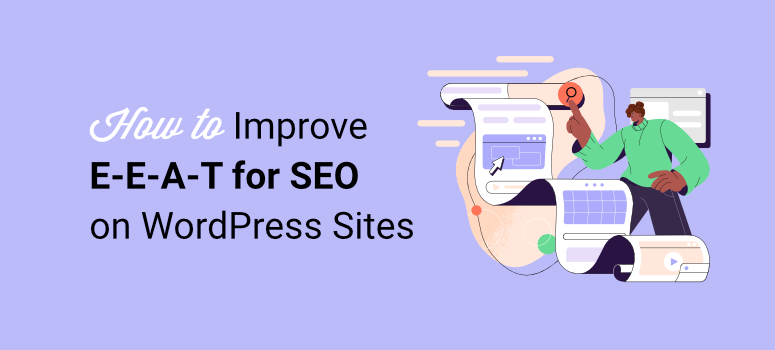

I’ve been working with WordPress and SEO for a long time now. During this time, I have evolved and adapted to new SEO techniques.
One thing that has remained constant is that SEO has undergone significant changes since I began. Any SEO expert will tell you that it looks very different these days.
For example, I saw people stuffing keywords everywhere online. They also built those low-quality spam links to improve their rankings.
But those old SEO techniques no longer work!
Today, Google focuses on E-E-A-T. This stands for Experience, Expertise, Authoritativeness, and Trust.
As someone who runs multiple WordPress sites, I had to change my SEO approach fully to stay competitive online.
I’ve also seen many WordPress site owners struggle with this shift. For some, their rankings dropped even after trying to implement E-E-A-T because they did not follow best practices.
But here is the good news.
If you are using a WordPress site, you can quickly improve E-E-A-T with simple but practical steps.
I’ve experimented with different EEAT SEO techniques on dozens of websites and found the most effective ways to show expertise and build trust in WordPress.
This guide will share the exact steps that worked for me.
You’ll learn practical ways to boost your E-E-A-T signals. We will use WordPress features and proven strategies.
What is E-E-A-T?
As mentioned, I’ve seen SEO change quite a bit, and one major reason is the focus on E-E-A-T. With such a keen focus, E-E-A-T is an SEO concept we all need to understand now.
E-E-A-T stands for Experience, Expertise, Authoritativeness, and Trust.
With this, Google aims to help users find the most relevant information online. They want to ensure the content is reliable and comes from credible sources.
In the end, Google aims to assist users in finding reliable answers to their questions.
Now, I’ve learned that E-E-A-T isn’t just one score Google checks.
It’s more like a guiding principle for how Google’s systems understand your site’s overall quality.
It takes real effort and time to build genuine authority and trust online. As a result, this shift can feel challenging at first, you see.
But let me simplify it for you.
Now, since this article discusses what EEAT is, tips to improve it, and tools to help you, we have broken it down into sections. Select one of the links below to skip to the section you want to read.
With that, let’s delve into the details of E-E-A-T and how to utilize it to enhance SEO.
Understanding E-E-A-T in Detail
Now that we understand what E-E-A-T is and why it matters, let’s take a closer look at each part. To better understand EEAT, it’s helpful to break down each letter in the acronym to understand its significance for your site.
Experience (E)
Let’s start with the first ‘E’ that stands for Experience.
This part is all about first-hand involvement and actually doing something yourself.
I’ve found that the Experience factor has become much more important recently. This is partly due to the emergence of new AI tools.
Tools like ChatGPT can quickly generate large amounts of text. But this content often lacks real personal insight.
Added to that, AI content can sometimes just repeat things already online. As a result, it might not bring anything new to the table.
So, Google started putting more weight on real experience. They want to see that a person used a product or visited a place.
In the case of your business, you actually have the experience to educate others looking for answers in the field.
As a result, Google prioritizes personal stories and insights gained in your industry. As you can imagine, this shows the content isn’t just pulled from other websites or generated with AI.
One way I demonstrate my experience is by including examples from my projects. This is a quick way of sharing what I saw or did, adding that layer of experience.
This shows readers and search engines that I am knowledgeable on the subject, as I have experienced it firsthand. As a result, it proves that the information comes from real-life practice.
Expertise (E)
We just discussed experience, having that firsthand knowledge. Right after that comes the second ‘E’, which is Expertise.
These two ‘E’s go hand-in-hand as Expertise is about having deep knowledge and skills in a topic.
Expertise means you have a thorough understanding of the subject you’re writing about. Apart from that, it demonstrates that you possess the necessary skills to explain it effectively.
I’ve learned that showing expertise is key as it helps readers trust that the information you share is accurate and helpful.
This is because expertise indicates that your content provides genuine and valuable insights about your area of business.
To improve the Expertise SEO signals, I focus on breaking down complex ideas clearly. I ensure that the article thoroughly explores the topic, showing readers I am an expert.
As a result, readers can quickly tell that I know more than just the basics.
Authoritativeness (A)
Now let’s get into the ‘A’. This part of E-E-A-T is about Authoritativeness.
Authoritativeness means how much your website is seen as a trusted source on your topic of expertise. It’s about being a go-to place for information.
So, I think of it as your site’s reputation in its specific area. This is because Authoritativeness shows Google and users that you are a leader or authority in the space.
To analyze authoritativeness, Google looks for signs that a real company or person is behind your site. To be clear, this isn’t just some random page online that you have created.
It needs to show the knowledge and skills of the people creating the content or offering services for your company or team.
That is why it is so important today to focus on creating a strong personal brand. This helps people connect better with the expert or team behind the site.
On top of this, I’ve learned that making it easy for people to contact you is key. As a result, having clear contact pages shows you are available and real.
Your website should also be simple for visitors to use. That is, it needs to be helpful and serve its purpose well.
On top of that, updating your site’s content often is important. This is because fresh information shows your site is active and current.
Trustworthiness (T)
We’ve covered Experience, Expertise, and Authoritativeness. Now it’s time for the final letter in E-E-A-T.
That last letter is ‘T’ and it stands for Trustworthiness.
Trustworthiness means your website is credible and reliable. People need to feel safe and confident when visiting your site and using your information.
To me, this is one of the most important parts of EEAT because if users don’t trust your site, the other “EEA” Signals don’t matter as much.
Now, building trustworthiness involves several key elements, including accuracy, transparency, and privacy and security.
- Accuracy: Means the information on your site is correct and factual. I always double-check facts before publishing anything.
- Transparency: Means being open with your users. This includes how you use their data and who is behind the site, you see.
- Privacy and Security: These are important in building trust. Users need to know their information is safe with you. I make sure my sites have proper security measures in place. I also clearly state my privacy policy for visitors.
Now that you understand what E-E-A-T is, let us look at actionable techniques to improve your SEO and site rankings.
Specific Ways to Improve Your E-E-A-T
We’ve just broken down what E-E-A-T means: Experience, Expertise, Authoritativeness, and Trust. Now, let’s talk about putting that into action on your WordPress site.
1. Create Helpful Content
The first and most important step in boosting E-E-A-T is your content itself. As mentioned, it needs to be genuinely helpful and original content. It shouldn’t just repeat what is already on other sites.
So how do you create helpful and original content?
First, the content should be experience-centric. A good way to highlight this is by creating first-hand knowledge and personal stories.
But writing content focusing on personal stories is not enough, it should also focus on a people-first approach. For example, I focus on answering reader questions, rather than simply adding keywords everywhere.
The best way to create people-first content is to conduct thorough research. I dig deep to find accurate information for my articles on forums like Reddit, where actual users engage.
While SEO keywords can help you find out what people are searching for, looking at forums helps you understand how they talk about it, what they struggle with, and what real answers they’re looking for.
On top of that, I focus on Detail.
I ensure that I cover a topic thoroughly so readers get a comprehensive understanding. My aim is to ensure that I answer all the questions users may have on the post to improve dwell time.
Dwell time is an SEO signal that tells Google how long someone spent on your site. The longer they stay, the more likely they are to get the answers they were looking for.
And in turn, this tells Google that your site is the right place to get these answers.
2. Provide Transparency and Author Info
People want to know who is behind the words they read online to decide if they can trust the information.
That is why I ensure I add an author’s bio on every post. This informs readers about the author of the article, where they can find more of their content and why they are an expert in the field.
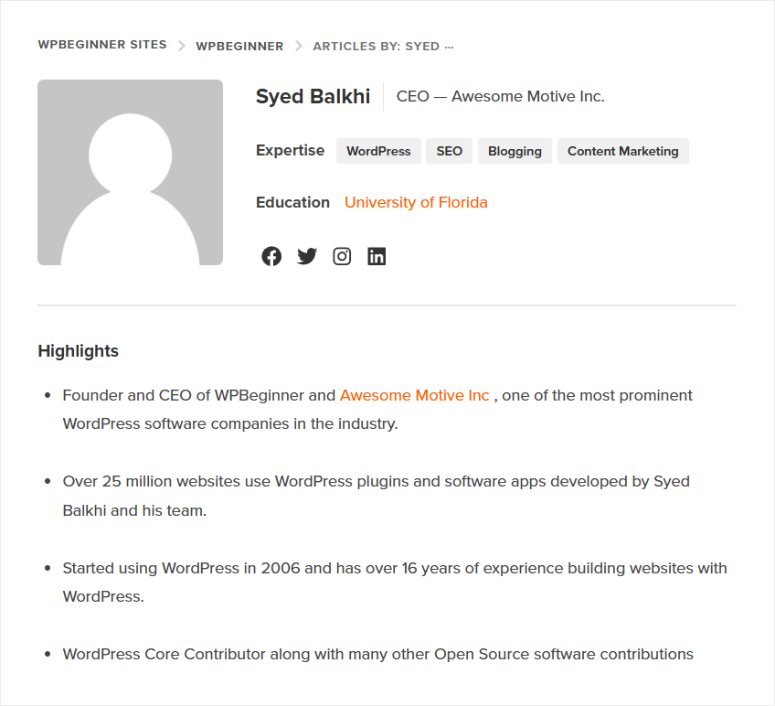

Added to that, I clearly state the content intention. Why was this article written, and what should readers get from it?
As a result, the reader knows exactly what to expect. They’re more likely to stay, read through, and take action because the content feels purposeful and genuinely helpful.
If others were involved in creating the content, it’s important to be transparent about that.
Clearly listing contributors, whether they helped with research, writing, editing, or providing expert input, adds credibility to your work.
On top of that, it shows that the content isn’t just one person’s opinion, but a collaborative effort backed by different perspectives or areas of expertise.
This is because readers appreciate knowing who was involved, especially when the topic requires deep knowledge or firsthand experience.
In the end, it builds trust and shows that your content was thoughtfully and carefully created.
The best way to showcase the author bio and collaborators is to use Schema Markup.
This helps search engines understand who wrote the content. It structures the author and organization info for them.
I use Schema Markup to help Google connect the content to the person or team behind it, helping build Authoritativeness.
apart from that, including disclaimers and transparency statements is crucial.
This builds trust with your audience. For example, I’ll state if something is an opinion or if a post is sponsored.
3. Use Credible Sources
When I write about a topic, I always seek out reliable sources for information, helping build Trustworthiness.
Citing reputable journals and websites is a practice I consistently employ, as it enhances the accuracy and authority of my content.
My favorite approach is linking to trusted news sources, academic journals, and official research papers.
These types of outlets provide up-to-date information that has been reviewed, fact-checked, or backed by credible institutions.
This is important because readers and search engines value content that’s supported by real evidence.
When I reference a well-known source, it not only helps explain complex topics more clearly, but it also shows that I’ve taken the time to verify the facts.
It’s one of the simplest ways to build trust and show that my content isn’t based on guesswork, but on solid, reliable information.
Added to that, I make sure to link to original studies when possible.
I link directly to the study itself to let readers see the source data for themselves. I find this helps show the depth of my research and expertise.
It also proves that I am not just repeating information from other blogs. I am going back to the original facts.
4. Create a Positive Brand Reputation
Your online reputation plays a big role in how Google views your site’s authority and trustworthiness.
It’s not just about what you say on your website. It’s also about what others say about you across the web.
Reviews, mentions, backlinks from respected sites, and even social signals all contribute to your digital credibility.
This concept mirrors real life.
Just like people tend to trust a business that’s recommended by others or has a strong presence in the community, Google trusts websites that are talked about positively and consistently online.
If your name shows up on reliable sites, in expert roundups, or through satisfied customer reviews, it builds a picture of reliability.
As a result, the stronger your reputation, the more likely Google is to treat your content as high-quality and worth ranking.
It’s all about showing you’re a trusted voice, not just through your words, but through the broader conversation around your brand.
I actively work on building a good name for my sites. It requires effort beyond just writing articles.
Here are my favorite ways to build a brand:
- Using Digital PR: Getting featured on reputable websites or in online publications helps increase your visibility and authority. It shows that others recognize your work and are willing to cite or mention it, which builds trust with both users and search engines.
- Influencer Marketing: Collaborating with influencers in your niche can significantly expand your reach. When someone your audience already trusts endorses your brand, it creates instant credibility and interest.
- Guest Posting: Submitting well-crafted articles to relevant websites is a tactic I regularly use. It allows me to share valuable insights with a new audience while establishing authority in my industry.
- Managing Social Media: Staying active and engaging on platforms like Twitter, LinkedIn, or Instagram helps build a loyal community. Responding to comments and sharing useful content keeps your brand top of mind and humanizes your voice.
- Testimonials: Displaying positive feedback from happy clients or customers is a powerful way to build trust. It offers social proof that your product or service delivers real value.
- User-Generated Content (UGC): Encouraging comments, reviews, or shared posts from users shows your brand is active and appreciated. But it’s important to moderate and highlight quality contributions to keep things positive and on-brand.
- Case Studies and Success Stories: I focus on sharing detailed case studies that show how my strategies deliver results. Real examples of success give potential clients confidence in your process and prove your expertise in action.
All these activities build a stronger name for your website. They show Google and users that your site is known and trusted in its field.
5. Build Authoritative Backlinks
Let us now look at building authoritative backlinks. It is important to remember that not all links are created equal now.
Even though the weight of links has reduced in SEO, they still matter, especially if done right.
This is because Google cares more about the right kind of links today.
I’ve learned that it’s not about collecting hundreds of random backlinks. What really matters is earning links from trusted, relevant websites that actually make sense for your content.
This means you should focus on quality over quantity.
One good link from a respected site is better than many low-quality ones.
So, getting links from sites that are seen as authorities boosts your own authority and tells Google that others in your field trust you.
And as mentioned, links should come from websites related to your topic or industry.
A link from another SEO site helps me show my expertise in that area. A random link from an unrelated site doesn’t help as much.
I focus my efforts on earning links from reputable sites within my space. This strategy has helped my sites build stronger E-E-A-T signals.
In a nutshell, with E-E-A-T, link building is less about quantity and more about earning trust and recognition from credible, relevant sources. It’s about building real authority, not just chasing numbers.
We’ve talked about creating helpful content, being transparent, using good sources, building reputation, and getting quality links.
Now, let’s look at some tools I’ve used that can make E-E-A-T easier.
1. All in One SEO (AIOSEO)
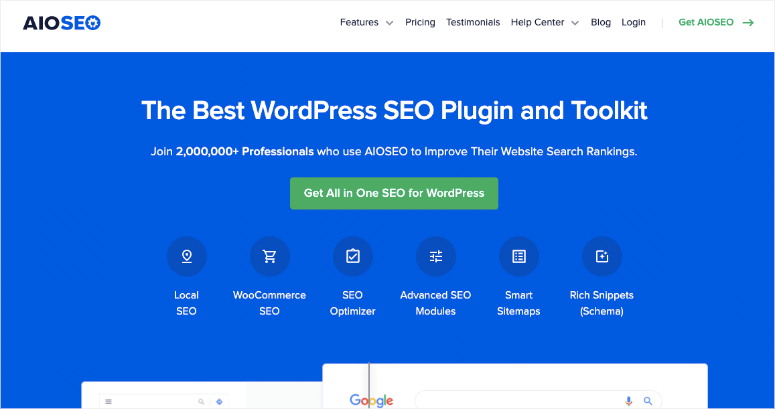

All in One SEO (AIOSEO) is a powerful WordPress plugin packed with features that help strengthen your site’s E-E-A-T signals.
I rely on it to handle key technical SEO elements that support trust, expertise, and authority.
One of the most useful features is its Schema Markup support. AIOSEO lets me add structured data to posts and pages, helping search engines understand who wrote the content and what it’s about.
I use this to attach author bios, link them properly, and highlight credentials, boosting both Authoritativeness and Trust.
Beyond authorship, AIOSEO helps structure other critical details like organization info, article types, and more. These extra layers of context send clear quality signals to Google.
Another helpful tool is its content score system, which rates your post for readability and SEO-friendliness as you write. This ensures the content is easy to understand and genuinely helpful—two factors that support the Expertise aspect of E-E-A-T.
AIOSEO also offers internal link suggestions, recommending relevant content to link within your post. These contextual links improve navigation, increase time on site, and show depth, helping build overall authority.
For me, AIOSEO simplifies the technical aspects of E-E-A-T, allowing me to focus more on creating valuable content.
Check out our AIOSEO review here.
2. PushEngage
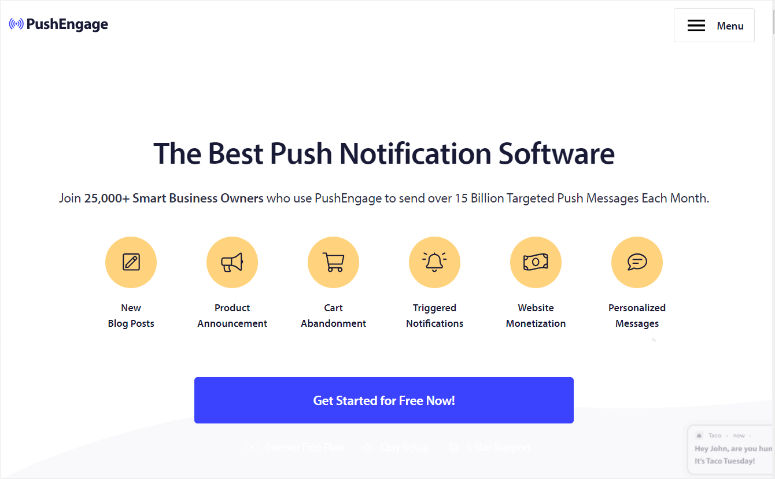

PushEngage is a tool that helps you use web push notifications. It lets you send messages directly to people who visit your site, even when they are about to leave.
I’ve used this to keep visitors engaged with my content, improving my dwell time. As mentioned, this tells Google that your content is helpful.
On top of that, PushEngage popups can appear even when a user is not on your site, bringing back returning visitors.
This shows search engines that my site is active and provides ongoing value. As a result, it helps build my site’s authority over time.
Check out the latest PushEngage review here.
3. Smash Balloon
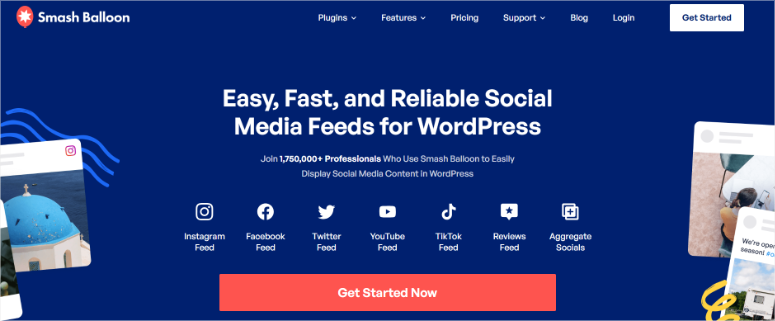

Smash Balloon is the best social media feeds plugin for WordPress websites. It pulls content from social media platforms like Instagram, Facebook, TikTok, Twitter, and more.
Displaying active social profiles shows there is a real brand and community behind the site, helping build trust.
It boosts your site’s authority and shows you have a presence outside of just your website.
Check out this updated Smash Balloon review.
4. RafflePress
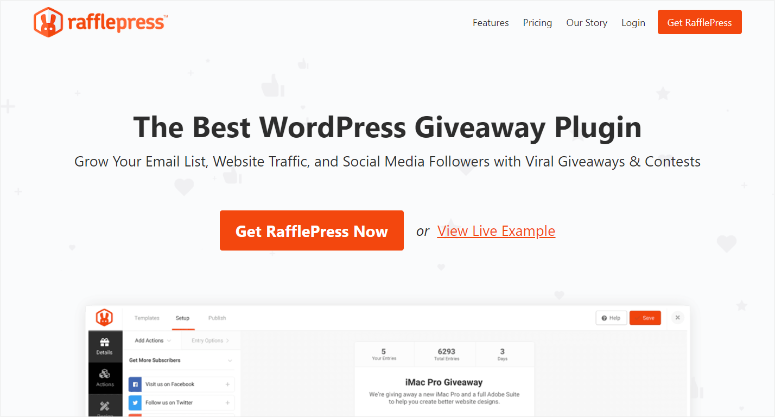

RafflePress is the best contests and giveaways plugin for WordPress sites. It’s designed to engage people and inspire excitement without coding.
I’ve used contests to increase how much users engage with my site, leading to more social shares.
This activity creates positive buzz around your brand. On top of that, it helps show that your site is popular and has influence in its niche, supporting your site’s authority.
Check out the RafflePress review here.
5. WPConsent
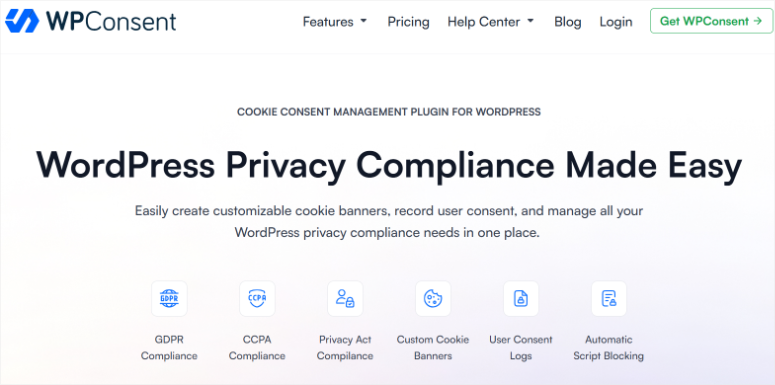

WPConsent is a simple yet powerful tool for managing cookie consent on your website.
It helps you stay compliant with major privacy regulations like the GDPR, CCPA, and others by giving users clear options to accept or reject cookies.
This GDPR plugin automatically displays a customizable consent banner and keeps track of user preferences.
So, you’re not only protecting user rights but also protecting your business from potential legal issues.
Showing visitors that you take their data privacy seriously is more important than ever. People want to know how their information is being used, and they expect transparency.
I use WPConsent to ensure that my site is up to date with the latest privacy standards.
6. LowFruits
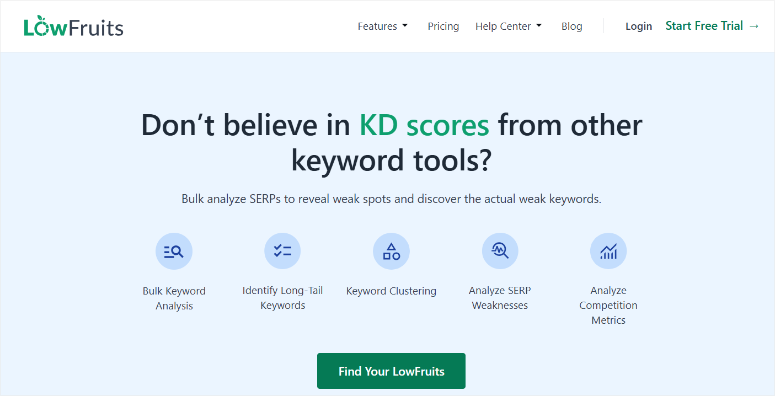

LowFruits is a tool I use for finding content ideas. It’s great at showing me specific questions people are asking online.
On top of that, it helps me discover topics with lower competition that I can target. My favorite feature is helping you find useful long-tail keywords.
This not only helps me create people-first content, but also is great for Voice SEO, which is quickly taking over.
As a result, LowFruits lets me create highly specific and detailed content that directly answers what users need. This is helpful and showcases my expertise, building trust.
Check out the latest LowFruits review here.
7. TrustPulse


TrustPulse displays small notifications on your site showing recent activity. It might show someone just signed up or made a purchase.
This provides live social proof to visitors. It shows that other real people are interacting with and trusting your business or content.
I find this is a powerful way to instantly build perceived trustworthiness. It helps new visitors feel more confident about your site.
Check out our TrustPulse review here.
8. ClickSocial
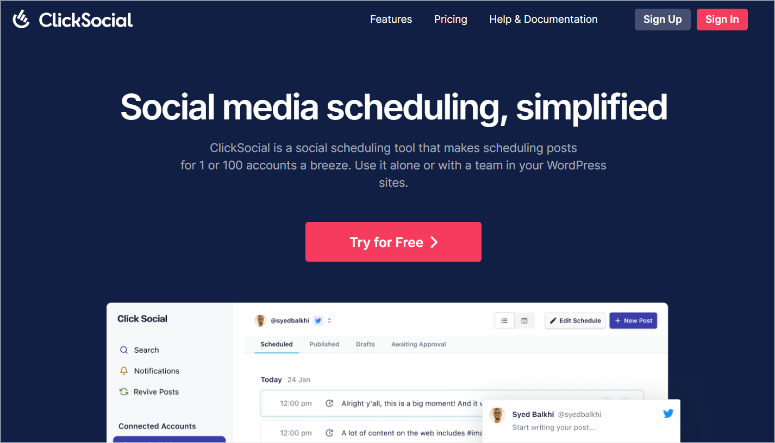

ClickSocial is the best social media scheduling and management plugin. It makes it easier to post updates and connect with your audience on different platforms.
I use it to keep my social profiles active automatically. Plus, the calendar allows me to schedule posts for as long as I like, meaning my accounts will always remain active.
My favorite ClickSocial is the Revive Posts.
With this feature, this social media plugin automatically reposts my old, performing content. This helps bring in more traffic while keeping my social activity.
Being visible and engaging on social media helps build brand presence.
This activity supports your site’s authority. It shows that a real person or team is behind the content and is active in the community.
Great! You now know the best EEAT practices and the tools to improve it. But with SEO constantly changing, it is a good idea to stay ahead of it.
What’s Next? (The Future of SEO)
As mentioned, it’s important to look ahead at what might be coming next in SEO. I’m always watching how search is evolving, and so should you.
For example, AI search engines are already starting to reshape things. Tools like Google SGE and Bing Copilot are changing how people find information.
These AI helpers often summarize answers directly. This means people might not click through to websites as often.
Added to that, we are seeing more Visual search and multimodal content. People are searching with images and using different types of media.
Zero-click answers are also becoming more common. Google tries to provide you with the answer directly on the search results page.
So, how do you adjust to this?
All this means we need to think beyond just getting clicks or traffic.
- Engagement: You need to really focus on keeping users interested once they land on your site. It’s not just about getting clicks, it’s about holding attention and providing value.
- Visibility: Ranking number one isn’t the only goal anymore. Being visible in different search formats like featured snippets, image packs, and video results matters just as much.
- Trust: Building trust with your audience is more important than ever. People want to feel confident that your content is accurate, honest, and backed by real experience.
- Flexibility: Staying adaptable is key in SEO. Search will keep evolving, but the core principles—creating value and building trust—will always stay relevant.
That’s it for today. I hope you enjoyed learning about how to improve your E-E-A-T for your WordPress website.
Now, here are 10 Best SEO Tools to Grow Your Website Traffic, apart from the list of plugins above.
On top of that, here are other articles you may be interested in reading.
These articles will help you fully grasp the new direction SEO is taking. They are packed with tips, tools, and practical steps to take to help improve your site’s ranking.
منبع: https://www.isitwp.com/improve-e-e-a-t-for-seo/
